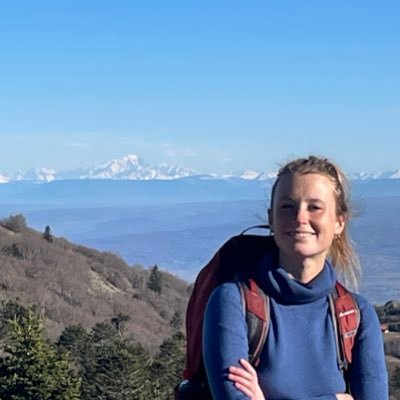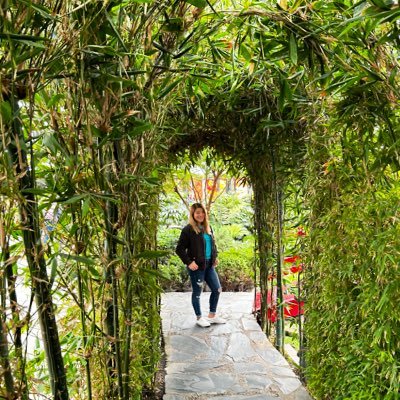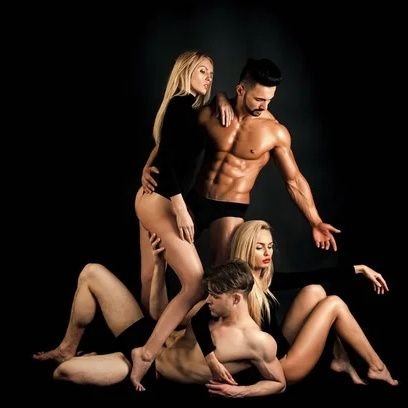
Camille Testard
@CamilleTestard
Followers
1,372
Following
579
Media
56
Statuses
540
Neuroscientist and Behavioral ecologist. PhD @UPenn Neuro. Now @Harvard Junior Fellow (2024-2027). Neurobiology of Social Behavior; Neuroethology
Joined October 2018
Don't wanna be here?
Send us removal request.
Explore trending content on Musk Viewer
Texas
• 231106 Tweets
England
• 149844 Tweets
Mustafa Kemal
• 140900 Tweets
Notre Dame
• 82234 Tweets
MSNBC
• 78856 Tweets
Kentucky
• 33719 Tweets
Arkansas
• 29942 Tweets
Iowa
• 28972 Tweets
Sabalenka
• 26144 Tweets
Auburn
• 18339 Tweets
Marshall
• 17620 Tweets
#AEWAllOut
• 16321 Tweets
#الهلاليين_يرفضون_لودي
• 15083 Tweets
Pegula
• 14066 Tweets
T-岡田
• 11854 Tweets
Ozee
• 11791 Tweets
#UFCVegas97
• 10841 Tweets
#ボクらの時代
• 10462 Tweets
Go Green
• 10311 Tweets
Last Seen Profiles
Pinned Tweet
*Very* excited to see the last study of my PhD making the cover of
@ScienceMagazine
on the macaques of
@CayoSantiagoPR
.
We show that ecological disturbances can alter selective pressures on social ties leading to persistent societal changes.
🧵👇
16
174
615
So immensely proud to see my PhD work out today in
@Nature
!
Combining neuroscience and ethology to an unprecedented degree in primates, we uncover neural signatures of social support and grooming reciprocity—building blocks of relationships.
🧵👇
21
168
860
Excited to share our new paper out today in
@CurrentBiology
!
We explore how Cayo Santiago monkeys changed their social dynamics in the aftermath of Hurricane Maria
Coauthored w/
@ljnbrent
@MichaelLouisPl1
@nyuprimatology
@SMack_Lab
et. al.
(1/16) 🧵👇
14
213
596
**NEW PREPRINT ALERT** co-authored w/
@seb_trem
(yes, 2nd in a week!!)
We show that inferring a brain area’s function from neural recordings alone can be misleading, with severe consequences to the field of neuroscience.
🧵👇 (1/10)
21
148
524
New paper out today in
@ScienceAdvances
!
We investigated how sociality relates to brain structure in a group of free-ranging rhesus macaques.
Co-authored w/
@MichaelLouisPl1
,
@jerome_sallet
, Cayo Biobank Research Unit et. al
(1/9) 🧵👇
2
79
170
*THRILLED* to share our latest work with
@seb_trem
& co in
@MichaelLouisPl1
’s lab!
Primates maintain long-term bonds through grooming and social support. How?
Here, we reveal neural signatures of natural social behavior in freely-moving macaques.
🧵👇
3
41
113
*Thrilled* to share our latest work with
@seb_trem
!
Pioneering work in rodents from
@anne_churchland
's group showed that spontaneous movements dominate neural dynamics across the whole brain. Is this also the case in macaque monkeys ?
🧵👇
1
36
79
Wonderful and incredibly talented comic artist right here!! Thanks so much for choosing to collaborate with me and make a dream come true 😍 Comic is such a powerful medium for science communication. I hope to see more of these!
How can social behavior affect survival after a natural disaster? HUGE congrats to
@CamilleTestard
and co-authors, whose study about Hurricane Maria's impact on
@CayoSantiagoPR
just came out in
@ScienceMagazine
! Check out the paper, the thread, and the COMIC. 🏝️🐒🐒🐒
4
58
161
2
9
59
Super excited to be at
#SfN2022
in SD! I’ll be talking about bridging behavioral ecology and neuroscience in primates, Sunday at 10:30am room SDCC 23. Incredible line-up for this nano symposium:
@neuroetho
@_janzimmermann_
@DMaisson
and more. Don’t miss it!
0
6
51
These findings show the potential of social flexibility to provide resilience to rapid and unpredictable environmental disturbances and emphasize a dynamic link between the environment and fitness consequences of social behavior. Illustrative work by amazing
@HuWantsToKnow
below
3
12
46
*Excited* to share our latest review with
@LauraNewman33
& co about our team's multi-disciplinary efforts to characterize
#aging
and its modifiers in the
@CayoSantiagoPR
macaques: from immunity, to brain, microbiome, gene regulation and more.
🧵👇
1
24
45
*Very* excited to attend
@EFP_GfP2022
for the next few days as a symposium co-chair with the wonderful
@DeMoorDelphine
and
@erin_sira
on the Why’s and How’s of social relationships in primates!
Check out the stellar speaker list from behavioral ecologists to neuroscientists👇
2
14
40
Excited to see my first first-author paper making it to the cover of
@CurrentBiology
! Picture by
@ljnbrent
illustrating the devastation of
@CayoSantiagoPR
after Hurricane Maria and the support monkeys found in each other in its aftermath 🐒🇵🇷
Delighted to have our paper featured on today’s cover of Current Biology! I took this shot 13mos after Hurricane Maria devasted Puerto Rico and
@CayoSantiagoPR
– it shows the sustained effects Maria had on the macaques who live there.
3
19
149
0
5
30
If you’re still around this morning at
#ISBE2022
and wonder about the long-term effects of
#Hurricane
Maria on the
#CayoSantiago
rhesus macaques, come check out my talk this morning at 11:45 in the main auditorium!
0
8
26
**STOKED** to see our work with
@seb_trem
& co out in
@NatureNeuro
today!
We investigate the effects of spontaneous movements on cognitive processing in the macaque cortex.
Detailed tweeprint below 👇
*Thrilled* to share our latest work with
@seb_trem
!
Pioneering work in rodents from
@anne_churchland
's group showed that spontaneous movements dominate neural dynamics across the whole brain. Is this also the case in macaque monkeys ?
🧵👇
1
36
79
0
10
25
If you're interested in how neuronal activity in the macaque brain relate to their intricate and flexible social behavior, check-out our recent study in
@Nature
with
@seb_trem
,
@MichaelLouisPl1
,
@KordingLab
and others! (Twitter thread available)
2
5
24
Yours truly from
@PennNGG
in
@MichaelLouisPl1
lab as well as
@ljnbrent
and
@jerome_sallet
labs, will discuss the neuroethology of primate social behavior - how the 🧠 represents the context of natural social interactions in rhesus macaques. [Tinbergen: Mechanism]
#EFP_GfP2022
1
6
20
Excited to share our latest results on how rhesus macaques of
#CayoSantiago
adapt their social behavior in response to a devastating hurricane at
#abs2020
! Watch online now and join the Q&A session on Friday, July 31st at 4 pm ET.
@MichaelLouisPl1
@ljnbrent
0
6
18
There’s more!!
@DeMoorDelphine
from
@CrabExeter
with
@ljnbrent
will discuss what
#MacaqueNet
, a global collaboration of macaque researchers, can tell us about the evolution of social relationships. Check out the new website! . [Tinbergen: Evolution]
0
6
17
Also coauthors:
@larsonsm
,
@monkeymullet
, Julia Lehmann,
@HarryHMarshall
,
@MarinaWatowich
, Angelina Ruiz-Lambidez, Cassandra Kaplinsky, Antonia Bernau and Matt Faulder (2/16)
1
2
16
*COMIC ALERT*: you saw a sneak peak a couple tweets up. I paired up with a fantastic comic artist, scientist and educator
@HuWantsToKnow
to make a graphic novel version of this study accessible to a wide audience. Check it out!
2
5
16
This work is of course the result of a HUGE team effort over decades!
@ljnbrent
@MichaelLouisPl1
@nyuprimatology
@SMack_Lab
@CayoSantiagoPR
. A very special thanks to the CPRC team as well as Josue Negron-Del Valle and Daniel Phillips without whom none of this would be possible.
1
3
16
Future work in collaboration with
@jerome_sallet
,
@kchiou
,
@SMack_Lab
and others will investigate the impact of this devastating hurricane on the physiology of these macaques, from genomics to brain morphology. (14/16)
1
1
15
This work was done in collaboration with
@InchauspeJeanne
& Dr. Michael Petrides. We thank
@CIHR_IRSC
for funding this work and look forward to discussing further this controversial but critical topic. (10/10)
3
1
15
In a 1st study published in 2021
@CurrentBiology
, we showed that, in the immediate aftermath of the disaster, macaques built new social relationships. But why did they do so? and was this social response persistent and adaptive?
1
3
14
Dr.
@erin_sira
from
@ljnbrent
lab
@CrabExeter
as well as
@nyuprimatology
and
@SMack_Lab
will tell us about age-based changes in social behavior in the
@CayoSantiagoPR
rhesus macaques. [Tinbergen: Development]
#EFP_GfP2022
1
5
14
Exciting science coming your way.
@neuroetho
is recruiting, don't let the opportunity pass you by!
It’s always a pleasure to mix art and science. I really enjoy having these relaxed conversations about ideas, dreams and work. Fantastic write up by
@RebeccaHorne500
at
@_TheTransmitter
and a really fun shoot with Simon Simard! Come join the fun! Recruiting RA, PhD and Postdocs!!
3
6
36
0
2
11
PhD student in human evolution Levada Cheng from the lab of Martin Surbeck and
@LirSamuni
@HarvardHEB
@MPI_EVA_Leipzig
will then tell us about the physiological correlates of intergroup aggression in
@kokolopori
male bonobos! [Tinbergen: Mechanism]
#EFP_GfP2022
1
4
11
Thankful for the beautiful coverage of our latest work in
@sciam
by
@LydiaDenworth
!
Great summary of our
#Nature
paper in
@sciam
. Thanks
@LydiaDenworth
#RobertSeyfarth
“These are, quite frankly, extraordinary discoveries" &
#MatthewRushworth
“It is as if the neurons are keeping track of a register of social credit and debit.”
1
28
100
0
1
11
This work would not have been possible without the Cayo Primate Research Center staff, and our field assistants Josue Negron and Daniel Philips! We also thank the Social Network Club at
@CrabExeter
for their feedback and insightful discussions. (15/16)
1
2
9
Wondering how aging affects gene regulation across the primate brain? Check out our group’s latest work right here 👇Co-led by amazing
@kchiou
and
@AlexDeCasien
🤩! Oh.. Higher ranked individuals have younger brain transcriptomic profiles 🧐
0
3
9
This work was possible thanks to an amazing team of scientists
@seb_trem
@ron_ditullio
@MichaelLouisPl1
@KordingLab
and twitterless Felipe Parodi and Kristin Gardiner! Special thanks to Robert Seyfart and
@neuroetho
as well for their support along the way.
2
0
9
Finally, a big thank you to our funding sources, including
@animalsocaging
,
@NIH
,
@NSF
and
@royalsociety
. 16/16)
1
1
8
Dr. Debottam Bhattacharjee
@debottam1991
from Jorg Massen’s lab
@UniUtrecht
@Apenheul
will discuss partner choice during cooperation in macaque societies. [Tinbergen: Mechanism/Evolution]
#EFP_GfP2022
1
3
8
This work was possible thanks to the herculean efforts of the Cayo Biobank Research Unit team (coordinated by
@monkeymullet
) collecting behavioral data and biological samples (including brains, blood, bones and much more), as well as the
@CayoSantiagoPR
team and co-authors! 9/9
0
0
8
Incredible opportunity to work in a cross-disciplinary and international team at the intersection of behavioral ecology, genomics and neuroscience!
@ljnbrent
and
@SMack_Lab
are outstanding mentors, highly recommend checking this out!
#PhD
studentship available! Work on
“Social Modifiers of Molecular Ageing Across the Brain” with me,
@eohomo
&
@SMack_Lab
in
@exeterpsych
Deadline Nov 2
@GW4BioMedMRCDTP
Project descrip:
Other info:
Apply:
1
84
58
0
0
8
Next, behavioral ecologist Dr. Oliver Schülke from
@uniGoettingen
@DPZ_eu
@PrimBehavEcol
will tell us about the role of mating strategies in the evolution of affiliative relationships from work in Thai Assamese macaques. [Tinbergen: Function]
#EFP_GfP2022
1
4
8
Very proud of this one and excited to support you along the way!!
I’m super excited to say that I will be starting my lab as Asst. Prof. at the University of Pennsylvania
@PennSAS
in the beautiful, vibrant, and sunny city of Philadelphia. My lab will lead an integrative approach to animal cognition in the lab and in the field!!
#recruiting
40
23
265
1
0
8
Really cool. Comparing neural dynamics across animals (n=8!!!) and species. We need more of this in systems neuroscience.
Very excited to share our latest work:
"Preserved neural population dynamics across animals performing similar behaviour"
Result of a great collaboration with
@joanna_chang_
@PresNCM
@jtdudman
@mattperich
@JAlGallego
See the
#tweetprint
below for a short summary 1/n
12
92
393
1
0
7
Interested in the neural basis of natural social interaction in freely moving macaques? Come see our poster at
#FENS2022
! S07-359
0
4
7
The session starts with professor Erica van de Waal from
@unil
, director of the Inkawu Vervet Project
@InkawuP
, telling us about social learning in wild vervets ! [Tinbergen: Development]
#EFP_GfP2022
1
3
7
Fabulous coverage of our work by
@WorldofZoology
! If you want a general overview of findings and implications, please give it a read 👇
New study in
@Nature
(
@camilleTestard
) reveals the intricate social lives of
#macaques
, offering insights into neural mechanisms of social behavior.
#Neuroscience
#SocialBehavior
0
3
6
2
1
6
Great blog post by
@anne_churchland
on our work with
@seb_trem
looking at the effect of movement on cognitive signaling in the macaque brain. We may somewhat differ in the interpretation of the cross-species comparison but glad to start this discussion!
1
0
6
I wrote a first thread when we preprinted this article, which you can find here:
TLDR: we reveal neural signals across the most diverse array of natural behavior ever before in primates, including fundamental social behaviors critical for survival.
*THRILLED* to share our latest work with
@seb_trem
& co in
@MichaelLouisPl1
’s lab!
Primates maintain long-term bonds through grooming and social support. How?
Here, we reveal neural signatures of natural social behavior in freely-moving macaques.
🧵👇
3
41
113
1
0
6
The work reviewed here is the result of a mind-boggling multi-disciplinary collaboration across 15+ institutions in Europe and North America as part of the
#CBRU
, coordinated by the one and only
@monkeymullet
and co-led by
@ljnbrent
,
@SMack_Lab
,
@nyuprimatology
,
@MichaelLouisPl1
!
1
2
6
Thanks to the PIs acknowledged above +
@MeliSandalia
,
@AlexDeCasien
,
@kchiou
,
@mareikecora
,
@EcoEvoEve
,
@MarinaWatowich
,
@rachpetersen
, twitterless contributors, and
@NIH
for supporting our work!
1
0
5
@jcbyts
@NicoleCRust
@KordingLab
@seb_trem
@nienborglab
This is perhaps very much known but also very much ignored in the field when interpreting results. This study adds to the evidence that you,
@realAlexHuk
and others have provided on the non-necessity of neuro-behavioral correlations brain-wide.
2
0
5
Very excited to be here and really enjoyed talking about all things primate neuroethology today. Looking forward to many more chats this week!
Very happy to host
@CamilleTestard
for this whole week at
@CBehav
. So happy to have you around 🙌🙌
0
2
12
0
1
5
@jcbyts
@NicoleCRust
@KordingLab
@seb_trem
@nienborglab
@realAlexHuk
I think this calls for 1. Emphasis on establishing causal frameworks to interpret correlations and 2. Investigating why these non-necessary signals are so prevalent.
1
0
5















































































